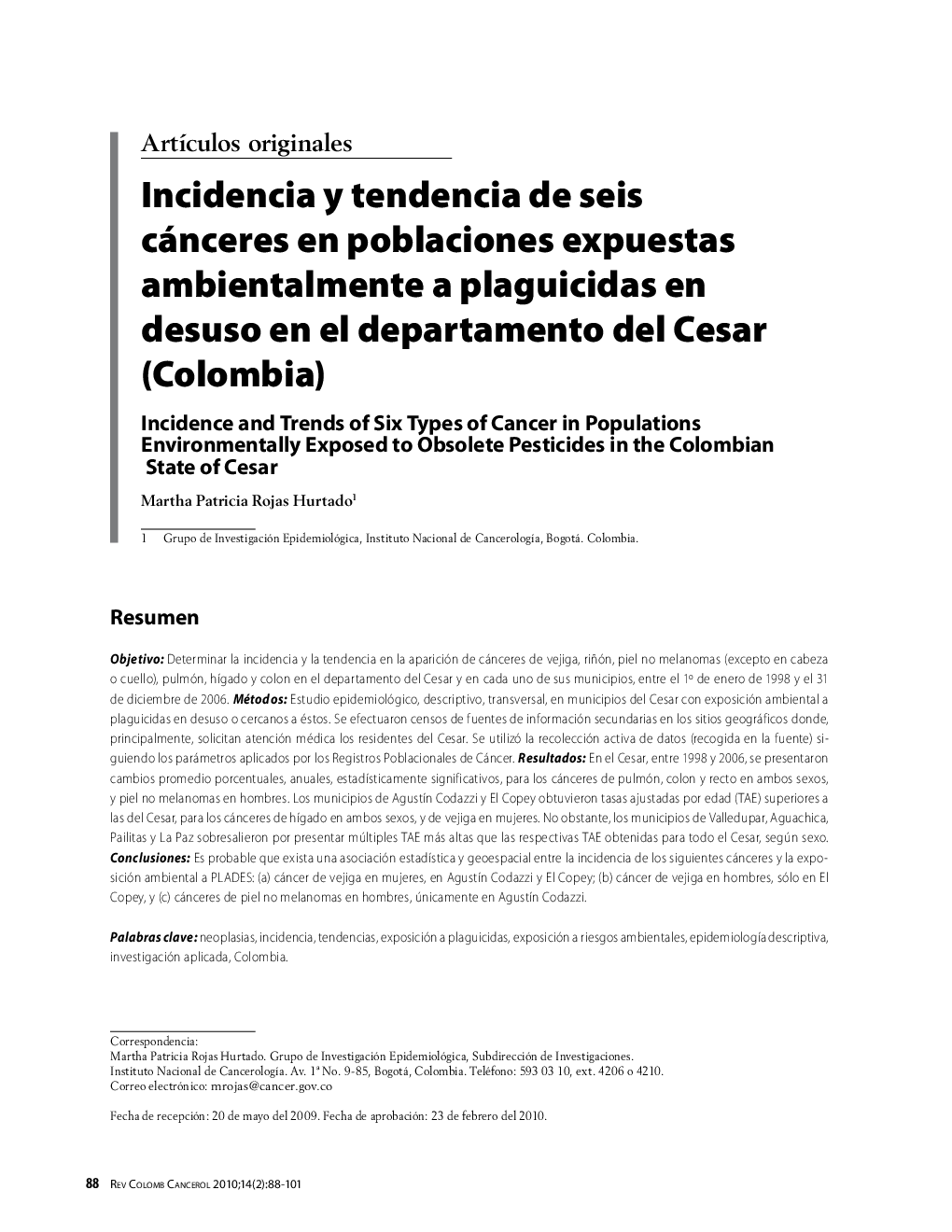| Article ID | Journal | Published Year | Pages | File Type |
|---|---|---|---|---|
| 3997261 | Revista Colombiana de Cancerología | 2010 | 14 Pages |
ResumenObjetivoDeterminar la incidencia y la tendencia en la aparición de cánceres de vejiga, riñón, piel no melanomas (excepto en cabeza o cuello), pulmón, hÃgado y colon en el departamento del Cesar y en cada uno de sus municipios, entre el 1° de enero de 1998 y el 31 de diciembre de 2006.MétodosEstudio epidemiológico, descriptivo, transversal, en municipios del Cesar con exposición ambiental a plaguicidas en desuso o cercanos a éstos. Se efectuaron censos de fuentes de información secundarias en los sitios geográficos donde, principalmente, solicitan atención médica los residentes del Cesar. Se utilizó la recolección activa de datos (recogida en la fuente) siguiendo los parámetros aplicados por los Registros Poblacionales de Cáncer.ResultadosEn el Cesar, entre 1998 y 2006, se presentaron cambios promedio porcentuales, anuales, estadÃsticamente significativos, para los cánceres de pulmón, colon y recto en ambos sexos, y piel no melanomas en hombres. Los municipios de AgustÃn Codazzi y El Copey obtuvieron tasas ajustadas por edad (TAE) superiores a las del Cesar, para los cánceres de hÃgado en ambos sexos, y de vejiga en mujeres. No obstante, los municipios de Valledupar, Aguachica, Pailitas y La Paz sobresalieron por presentar múltiples TAE más altas que las respectivas TAE obtenidas para todo el Cesar, según sexo.ConclusionesEs probable que exista una asociación estadÃstica y geoespacial entre la incidencia de los siguientes cánceres y la exposición ambiental a PLADES: (a) cáncer de vejiga en mujeres, en AgustÃn Codazzi y El Copey; (b) cáncer de vejiga en hombres, sólo en El Copey, y (c) cánceres de piel no melanomas en hombres, únicamente en AgustÃn Codazzi.
ObjectiveTo determine incidence and trends related to the appearance of bladder, kidney, non melanoma skin (except head and neck), lung, liver and colon cancer in the State of Cesar and in the entirety of its municipalities from January 1, 1998-December 31, 2006.MethodsA descriptive, transverse epidemiologic study carried out in the municipalities of the State of Cesar where environmental exposure to obsolete or near obsolete pesticides had occurred. Census of secondary information sources was conducted at main geographical points where state residents sought medical care. Active data collection (at the source) was employed in accordance with Population Cancer Registry.ResultsIn the State of Cesar, between 1998-2006, average annual percentage and statistically significant changes occurred in the incidence of lung, colon, and rectal cancers for both sexes, and of non melanoma skin cancer for men. The municipalities of AgustÃn Codazzi and El Copey revealed age standard rates (ASR) above the state average for liver cancer in both sexes, and for bladder cancer in women. Gender related multiple ASR for the municipalities of Valledupar, Aguachica, Pailitas and La Paz stood out with respectively higher ASR than that for the entire State of Cesar.ConclusionsIt is possible that there is a statistical and geospatial association between the incidence of the following cancers and the environmental exposure to PLADES: (a) bladder cancer in women, in AgustÃn Codazzi and El Copey; (b) bladder cancer in men, only in El Copey, and (c) non melanoma skin cancer in men, only in AgustÃn Codazzi.
